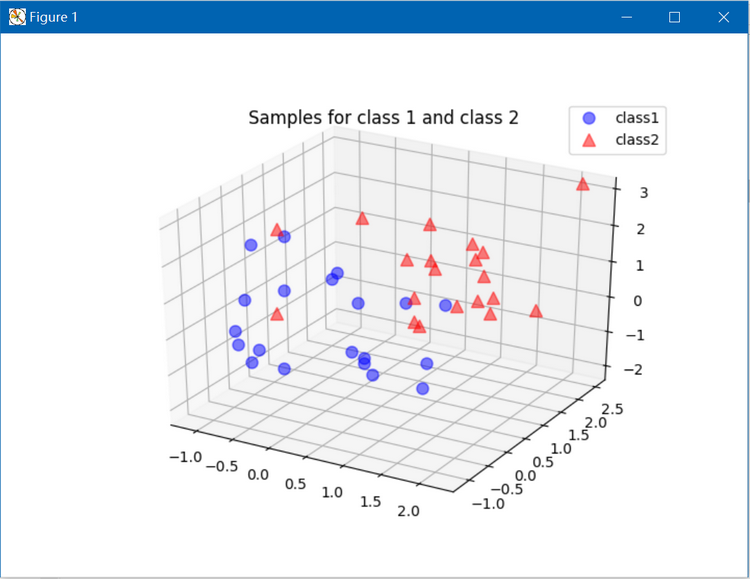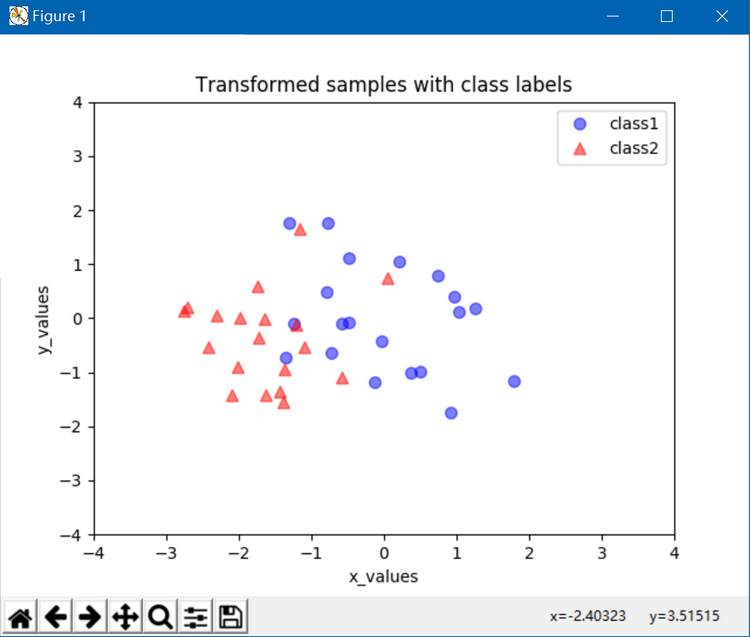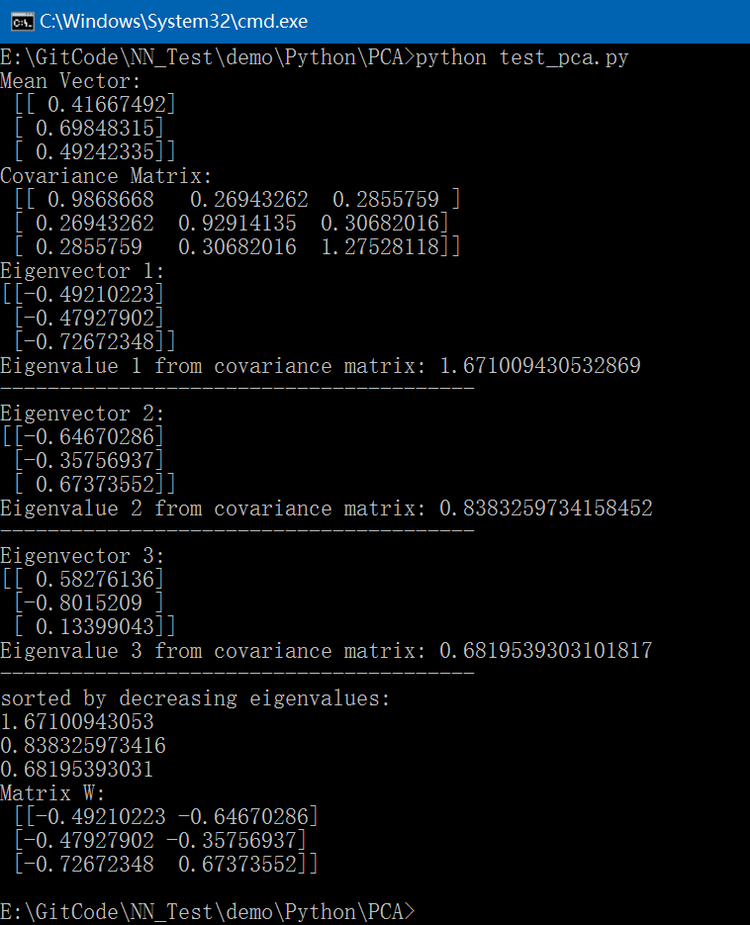主成分分析(Principal Components Analysis, PCA)简介可以参考: http://blog.csdn.net/fengbingchun/article/details/78977202
这里是参照 http://sebastianraschka.com/Articles/2014_pca_step_by_step.html 文章中的code整理的Python代码,实现过程为:
1. 随机生成3行*40列的数据集,每一列代表一个样本,前20列属于类1,后20列属于类2;每一个样本特征长度为3;
2. 计算每行均值;
3. 计算协方差矩阵,产生一个3行*3列的矩阵;
4. 由协方差矩阵计算特征向量和特征值;
5. 按降序排序特征值和特征向量;
6. 选择第一主成分和第二主成分组成一个新的3行*2列的矩阵;
7. 根据产生的3行*2列矩阵重建原有数据集。
Python代码如下:
# reference: http://sebastianraschka.com/Articles/2014_pca_step_by_step.html
import numpy as np
from matplotlib import pyplot as plt
from mpl_toolkits.mplot3d import Axes3D
from mpl_toolkits.mplot3d import proj3d
from matplotlib.patches import FancyArrowPatch
# 1. generate 40 3-dimensional samples randomly drawn from a multivariate Gaussian distribution
np.random.seed(1) # random seed for consistency
mu_vec1 = np.array([0,0,0])
cov_mat1 = np.array([[1,0,0],[0,1,0],[0,0,1]])
class1_sample = np.random.multivariate_normal(mu_vec1, cov_mat1, 20).T
assert class1_sample.shape == (3,20), "The matrix has not the dimensions 3x20"
#print("class1_sample:\n", class1_sample)
mu_vec2 = np.array([1,1,1])
cov_mat2 = np.array([[1,0,0],[0,1,0],[0,0,1]])
class2_sample = np.random.multivariate_normal(mu_vec2, cov_mat2, 20).T
assert class2_sample.shape == (3,20), "The matrix has not the dimensions 3x20"
fig = plt.figure(figsize=(8,8))
ax = fig.add_subplot(111, projection='3d')
plt.rcParams['legend.fontsize'] = 10
ax.plot(class1_sample[0,:], class1_sample[1,:], class1_sample[2,:], 'o', markersize=8, color='blue', alpha=0.5, label='class1')
ax.plot(class2_sample[0,:], class2_sample[1,:], class2_sample[2,:], '^', markersize=8, alpha=0.5, color='red', label='class2')
plt.title('Samples for class 1 and class 2')
ax.legend(loc='upper right')
plt.show()
# Taking the whole dataset ignoring the class labels
all_samples = np.concatenate((class1_sample, class2_sample), axis=1)
assert all_samples.shape == (3,40), "The matrix has not the dimensions 3x40"
# 2. Computing the d-dimensional mean vector
mean_x = np.mean(all_samples[0,:])
mean_y = np.mean(all_samples[1,:])
mean_z = np.mean(all_samples[2,:])
mean_vector = np.array([[mean_x],[mean_y],[mean_z]])
print('Mean Vector:\n', mean_vector)
# 3. Computing the Covariance Matrix
cov_mat = np.cov([all_samples[0,:],all_samples[1,:],all_samples[2,:]])
print('Covariance Matrix:\n', cov_mat)
# 4. Computing eigenvectors and corresponding eigenvalues
eig_val_cov, eig_vec_cov = np.linalg.eig(cov_mat)
for i in range(len(eig_val_cov)):
eigvec_cov = eig_vec_cov[:,i].reshape(1,3).T
print('Eigenvector {}: \n{}'.format(i+1, eigvec_cov))
print('Eigenvalue {} from covariance matrix: {}'.format(i+1, eig_val_cov[i]))
print(40 * '-')
# Visualizing the eigenvectors
class Arrow3D(FancyArrowPatch):
def __init__(self, xs, ys, zs, *args, **kwargs):
FancyArrowPatch.__init__(self, (0,0), (0,0), *args, **kwargs)
self._verts3d = xs, ys, zs
def draw(self, renderer):
xs3d, ys3d, zs3d = self._verts3d
xs, ys, zs = proj3d.proj_transform(xs3d, ys3d, zs3d, renderer.M)
self.set_positions((xs[0],ys[0]),(xs[1],ys[1]))
FancyArrowPatch.draw(self, renderer)
fig = plt.figure(figsize=(7,7))
ax = fig.add_subplot(111, projection='3d')
ax.plot(all_samples[0,:], all_samples[1,:], all_samples[2,:], 'o', markersize=8, color='green', alpha=0.2)
ax.plot([mean_x], [mean_y], [mean_z], 'o', markersize=10, color='red', alpha=0.5)
for v in eig_vec_cov.T:
a = Arrow3D([mean_x, v[0]], [mean_y, v[1]], [mean_z, v[2]], mutation_scale=20, lw=3, arrowstyle="-|>", color="r")
ax.add_artist(a)
ax.set_xlabel('x_values')
ax.set_ylabel('y_values')
ax.set_zlabel('z_values')
plt.title('Eigenvectors')
plt.show()
# 5 Sorting the eigenvectors by decreasing eigenvalues
# Make a list of (eigenvalue, eigenvector) tuples
eig_pairs = [(np.abs(eig_val_cov[i]), eig_vec_cov[:,i]) for i in range(len(eig_val_cov))]
# Sort the (eigenvalue, eigenvector) tuples from high to low
eig_pairs.sort(key=lambda x: x[0], reverse=True)
print("eig_pairs:\n", eig_pairs)
# Visually confirm that the list is correctly sorted by decreasing eigenvalues
print("sorted by decreasing eigenvalues:")
for i in eig_pairs:
print(i[0])
# 6 Choosing k eigenvectors with the largest eigenvalues
matrix_w = np.hstack((eig_pairs[0][1].reshape(3,1), eig_pairs[1][1].reshape(3,1)))
print('Matrix W:\n', matrix_w)
# 7 Transforming the samples onto the new subspace
transformed = matrix_w.T.dot(all_samples)
assert transformed.shape == (2,40), "The matrix is not 2x40 dimensional."
plt.plot(transformed[0,0:20], transformed[1,0:20], 'o', markersize=7, color='blue', alpha=0.5, label='class1')
plt.plot(transformed[0,20:40], transformed[1,20:40], '^', markersize=7, color='red', alpha=0.5, label='class2')
plt.xlim([-4,4])
plt.ylim([-4,4])
plt.xlabel('x_values')
plt.ylabel('y_values')
plt.legend()
plt.title('Transformed samples with class labels')
plt.show()


























 1875
1875

 被折叠的 条评论
为什么被折叠?
被折叠的 条评论
为什么被折叠?








